Spider-view: "The Specialist" (Spider-Man 2099, Part 2)
Miguel O'Hara's second trip into superheroics contrasts his Spider-Man with Peter Parker's...while the art creates a contrast with earlier issues
—by Nathan on February 22, 2025—
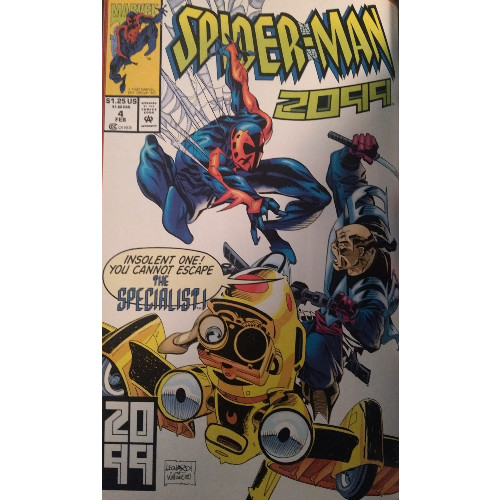
About a year ago, when we last left the intrepid Miguel O'Hara in the year 2099, the young man had been tricked into becoming addicted to a drug called Rapture by his boss Tyler Stone. In an effort to cure himself of the addiction, Miguel tested an experimental procedure on himself. The procedure worked, but as any good commercial for new medical innovations will tell you, side effects became present. Instead of any itching, aching, or difficulty breathing, Miguel grew talons and fangs, developed a sensitivity to light, and began shooting webbing out of his forearms.
Has your doctor ever warned you side effects may include turning into Spider-Man?
It's a weird new life Miguel has stumbled into, a new reality he doesn't want. Like most superheroes transformed by weird science, he wants to find a cure, remove the "Spider" from the "Man," much like Bruce Banner wants to eliminate the Hulk and Ben Grimm wishes to shed his rocky exterior.
But reality’s gonna push back a little in the form of a futuristic ninja who places our hero in a troubling position where Miguel must decide whether or not to embrace the spider.
"The Specialist"
Writer: Peter David
Penciler: Rick Leonardi
Inker: Al Williamson
Colorist: Rick Parker
Letterer: Noelle Giddings
Issues: Spider-Man 2099 (vol. 1) #4-5
Publication Dates: February 1993-March 1993
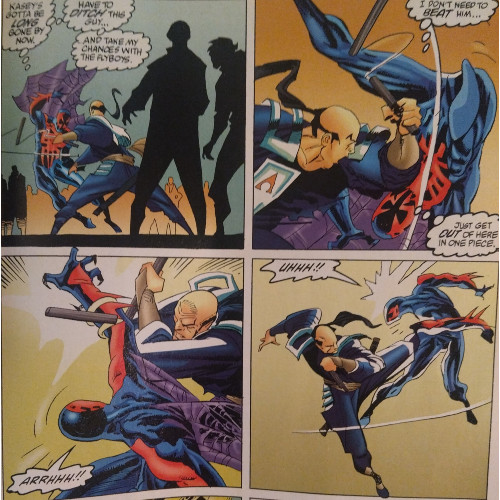
That old dollop of Spider-Man-branded wisdom is thrown at us fairly early in this narrative: "With great power comes great responsibility." Somehow, that phrase is still kicking around about one hundred years (give or take a few years, accounting for Marvel's sliding timescale and our ever-constant movement towards the end of the century) after the death of its intended original speaker. How Uncle Ben's famous nugget is still floating around in the public consciousness is never explained, but Miguel's brother Gabriel flashes it around when he needs his big brother's help. He says he learned it from his girlfriend Kasey, and only Thor knows where she heard it.
Regardless of how far-fetched it is for Ben's adage to have stayed alive far longer than its original speaker, the phrase speaks to the theme present in this two-part narrative: Miguel has the power, and despite how inadvertently he received his abilities, he is placed, like all good Spider-Men, in a situation where he's forced to make a choice. And he's not the only one, as we shall see…nor does he quite subscribe to the notion the same way his brother or spidery predecessor do.
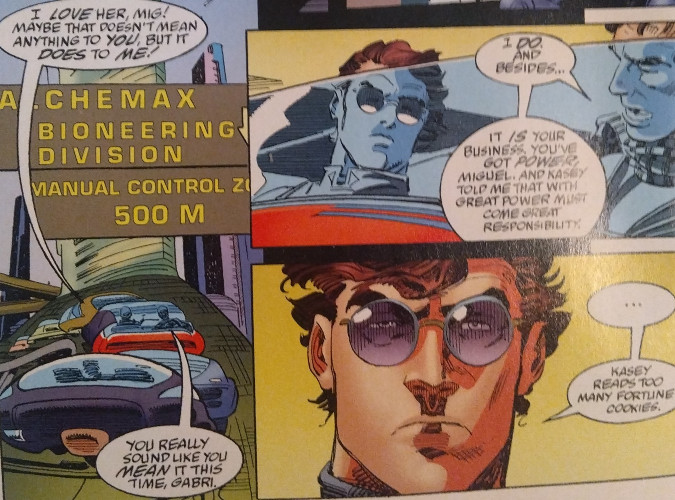
The differences between Miguel and Peter Parker, teased in the first arc, are made more apparent here. David intentionally distances his hero from the OG Spider-Man in ways beyond chronology. Early in the first issue, Miguel daydreams about attacking his boss and wanting to tear his throat out, showcasing a radical departure from Peter's mindset. That Miguel doesn't give in to these urges does provide him the restraint necessary to be a hero, but his tendency towards violence is notable. Peter has had his fair share of "give into the darkness and violence" story arcs, but those tales (when done correctly!) illustrate that such thinking is abnormal for Peter, that something must really set him off for him to forsake the morals he was raised to believe and embrace.
Miguel's tendencies are sharper (as are his claws), near the front of his mind and personality. There's not much to indicate why Miguel is prone to violence–we're not given any backstory or explicitly stated reason, and I prefer this. Miguel's actions, in his daydream and in actuality, lend themselves to hypothesizing about his state of mind and how he naturally leans in terms of disposition. His unfortunate circumstances have already developed empathy in us for him–it was Stone who hooked him on the drug, and a jealous coworker tampered with the experiment, which led to Miguel developing those aforementioned side effects. Miguel does cling to a bit of arrogance introduced in the initial arc, made apparent through a joking disdain towards an authority figure.
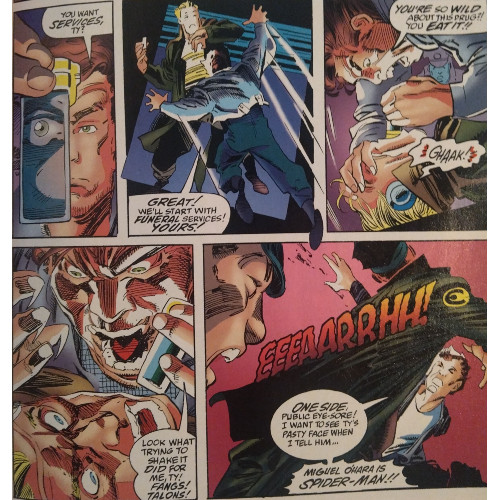
David challenges him in this arc, pushes him towards embracing that hero mantle, however reluctant Miguel may be. And unlike Peter, who initially used his powers and costumes for financial gain, Miguel's reasons begin more in service to his survival, becoming slightly more altruistic as he agrees to help his brother with a problem. He even serves as an unintentional inspiration to Gabriel's girlfriend Kasey, a revolutionary who puts her own life at risk to save Miguel after he rescues her. Yes, this is a common enough trope in comics–the reluctant hero who wishes to be stripped of his powers encountering situations where he is forced to accept his role as a hero.
Cliche the circumstances may be, but it's how Miguel reaches the deciding point that develops tension and further contrast between him and Peter. Reflecting on Gabriel's words on power and responsibility, Miguel dismisses them: "Wrong. Completely wrong," he says. "With great power comes great guilt." He acts, not out of selfishness or greed and not even out of a deep sense of knowing his powers must be used for the betterment of those around him. He's convicted by guilt, and though David has not done much yet to remark on his Irish-Mexican heritage, one is left to wonder if a hint of Catholicism drives the point home for Miguel. At Miguel's core is the belief that he's being "forced" into adopting the mask of Spider-Man. It almost feels, right now, that he's just doing a job because, well, if he doesn't, nobody else will.
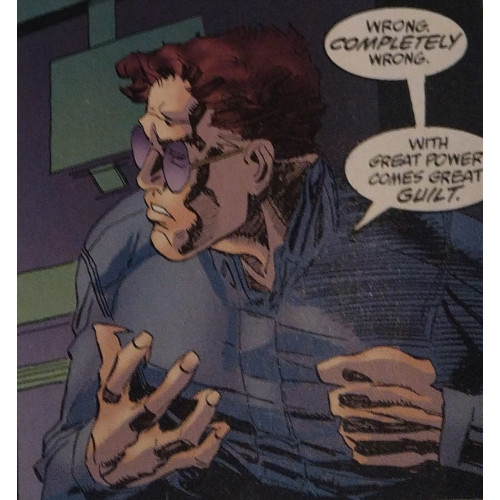
And that job includes facing the Specialist to save Kasey’s life. The Specialist himself is a unique creation–a samurai-like warrior who espouses witticisms about honor (or, more accurately, Miguel's lack thereof) while whipping throwing stars at him and trying to decapitate this new Spider-Man. He chides Miguel's lack of killer instinct, which Miguel responds to by saving his life later. The Specialist is driven by his own perspective of battle, maintaining respect for even those he's pursuing until cowardly actions such as retreat convince him otherwise.
The villain is equipped with a level of internal motivation Miguel doesn't quite possess, particularly as Miguel's aggressively violent nature clashes with the assassin's–the Specialist seeks not to necessarily kill, but even as he considers ending his fatal fight with Spider-Man, he wishes to at least unmask his foe and learn his identity prior to ending his life. It's another trope found often enough in comics–the villain preparing to reveal the hero's real identity–but David's introduction of this concept of honor adds an extra layer. The Specialist isn't merely showing society who Spider-Man is; he's revealing to the world the kind of man he wishes Spider-Man to die as, someone with a face and a name. Dying with a mask would have no honor.
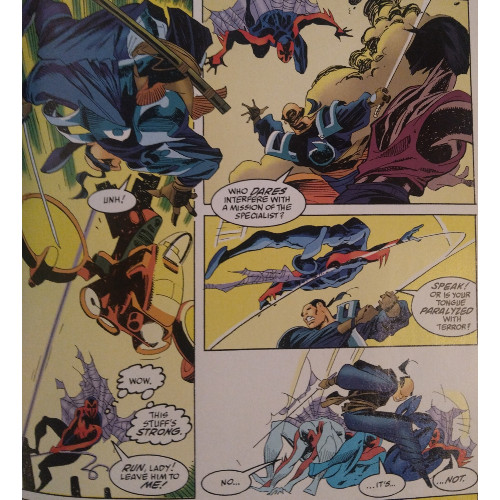
As the story unwinds to an intriguing conclusion–especially as to how it will flow into the next arc–David and Leonardi take the time to pepper the world with those fun futuristic details a narrative like this allows. They provide the 2099 version of the "phone booth costume change," with Miguel changing into Spider-Man and shipping his "civvies" straight back to his place. Imagine if Amazon had a store where you could try on clothes and have them sent directly to your home from the changing room; that's what the scene feels like (not too outlandish a concept now, is it?). Gabriel puts together a film project, using voice commands to edit a 3D holographic projector scene he walks through as he works. Cars zip along magnetic rails while others zoom by overhead. New York is stuffed to the point of claustrophobia with glittering skyscrapers, zipping vehicles, neon signs. The bustle never stops, even in the far future. I assume, in the early 90s, when these issues were first published, the technology seen here felt far more conceptual than it does now.
Artistically, the same players from the first arc are here, with Leonardi, Williamson, and Parker crafting this familiar yet wild future metropolis. The colors in this section feel wildly different from the first three issues and mark my only point of contention with this narrative. Everything is darker, more heavily shaded, and Leonardi's linework feels muted in comparison to how crisp those first issues are. Details such as faces lack the vivid expressions, calling to mind the recoloring done on Walt Simonson's Thor omnibus. But this is not a case of changing the coloring for the collected edition–looking up these issues online, I can confirm this was the style used to color them. Why the style changed, especially with the same personnel at the helm, I'm unaware, but I'm left wishing it hadn't.
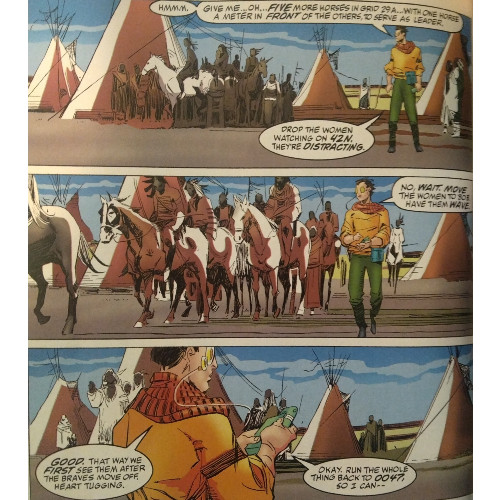
We're beginning to see the character of Miguel O'Hara become more fully realized as this series continues, and David and Leonardi make it clear just how unique this version of Spidey is. By casting a similar character in an unfamiliar setting, the creators explore unique aspects of a different Spider-Man without angering the fans who would grow upset if David and Leonardi had Peter Parker make choices like the ones Miguel makes. Miguel is a fresh white canvas, becoming tainted with the burden of violence while also bearing the colors of heroism. Forced heroism, for now, so we'll have to see how that alters, if it does, as the series progresses.